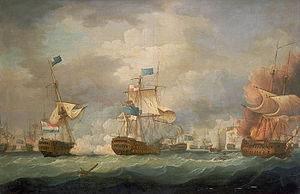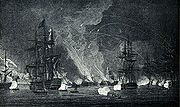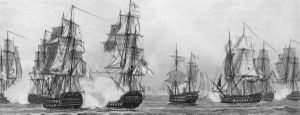
Thomas Whitcombe
Encyclopedia
Thomas Whitcombe was a prominent British maritime painter
of the Napoleonic Wars. Among his work are over 150 actions of the Royal Navy, and he exhibited at the Royal Academy, the British Institution and the Royal Society of British Artists. His pictures are highly sought after today.




 Thomas Whitcombe was born in London
Thomas Whitcombe was born in London
between 1752 and 19 May 1763, with the latter date frequently cited. Little is known of his background or training, although speculation based on the locations depicted in his paintings may provide some clues.
It is known that he was in Bristol
in 1787 and later travelled to the South Coast; there are few ports or harbours from this region that do not feature in his work. In 1789 he toured Wales
and in 1813 he travelled to Devon
, painting scenes around Plymouth
harbour. During his career he also painted scenes showing the Cape of Good Hope
, Madeira
, Cuba
and Cape Horn
. Between 1783 and 1824 he lived in London, including addresses in Covent Garden
and Somers Town
during the course of his exhibiting career.
His date of death, like that of his birth is uncertain; it was not before 1824, and possibly as late as 1834.
, Thomas Luny
, Francis Holman
and Robert Dodd
, a leading maritime painter of the French Revolutionary Wars
and Napoleonic Wars
. He painted over 150 actions of the Royal Navy
including fifty plates for The Naval Achievements of Great Britain, a splendid volume issued after the cessation of hostilities.
He exhibited at the Royal Academy
fifty-six times between 1783 and 1824 and once each at the British Institution
and the Royal Society of British Artists
. Many of his paintings are today in the collection of the National Maritime Museum
, Greenwich
, and in other important naval collections around the world.
Marine art
Marine art or maritime art is any form of figurative art that portrays or draws its main inspiration from the sea. Maritime painting is a genre that depicts ships and the sea—a genre particularly strong from the 17th to 19th centuries...
of the Napoleonic Wars. Among his work are over 150 actions of the Royal Navy, and he exhibited at the Royal Academy, the British Institution and the Royal Society of British Artists. His pictures are highly sought after today.
Life





London
London is the capital city of :England and the :United Kingdom, the largest metropolitan area in the United Kingdom, and the largest urban zone in the European Union by most measures. Located on the River Thames, London has been a major settlement for two millennia, its history going back to its...
between 1752 and 19 May 1763, with the latter date frequently cited. Little is known of his background or training, although speculation based on the locations depicted in his paintings may provide some clues.
It is known that he was in Bristol
Bristol
Bristol is a city, unitary authority area and ceremonial county in South West England, with an estimated population of 433,100 for the unitary authority in 2009, and a surrounding Larger Urban Zone with an estimated 1,070,000 residents in 2007...
in 1787 and later travelled to the South Coast; there are few ports or harbours from this region that do not feature in his work. In 1789 he toured Wales
Wales
Wales is a country that is part of the United Kingdom and the island of Great Britain, bordered by England to its east and the Atlantic Ocean and Irish Sea to its west. It has a population of three million, and a total area of 20,779 km²...
and in 1813 he travelled to Devon
Devon
Devon is a large county in southwestern England. The county is sometimes referred to as Devonshire, although the term is rarely used inside the county itself as the county has never been officially "shired", it often indicates a traditional or historical context.The county shares borders with...
, painting scenes around Plymouth
Plymouth
Plymouth is a city and unitary authority area on the coast of Devon, England, about south-west of London. It is built between the mouths of the rivers Plym to the east and Tamar to the west, where they join Plymouth Sound...
harbour. During his career he also painted scenes showing the Cape of Good Hope
Cape of Good Hope
The Cape of Good Hope is a rocky headland on the Atlantic coast of the Cape Peninsula, South Africa.There is a misconception that the Cape of Good Hope is the southern tip of Africa, because it was once believed to be the dividing point between the Atlantic and Indian Oceans. In fact, the...
, Madeira
Madeira
Madeira is a Portuguese archipelago that lies between and , just under 400 km north of Tenerife, Canary Islands, in the north Atlantic Ocean and an outermost region of the European Union...
, Cuba
Cuba
The Republic of Cuba is an island nation in the Caribbean. The nation of Cuba consists of the main island of Cuba, the Isla de la Juventud, and several archipelagos. Havana is the largest city in Cuba and the country's capital. Santiago de Cuba is the second largest city...
and Cape Horn
Cape Horn
Cape Horn is the southernmost headland of the Tierra del Fuego archipelago of southern Chile, and is located on the small Hornos Island...
. Between 1783 and 1824 he lived in London, including addresses in Covent Garden
Covent Garden
Covent Garden is a district in London on the eastern fringes of the West End, between St. Martin's Lane and Drury Lane. It is associated with the former fruit and vegetable market in the central square, now a popular shopping and tourist site, and the Royal Opera House, which is also known as...
and Somers Town
Somers Town, London
Somers Town, was named for Charles Cocks, 1st Baron Somers. The area in St Pancras, London, was originally granted by William III to John Somers, Lord Chancellor and Baron Somers of Evesham. It was to be strongly influenced by the three mainline north London railway termini: Euston , St...
during the course of his exhibiting career.
His date of death, like that of his birth is uncertain; it was not before 1824, and possibly as late as 1834.
Style
His range of work embraced naval engagements, ship portraits, coastal scenes with shipping and ships at sea in fresh breezes and storms. The topography of the background is interesting and well observed and the depiction of the ships themselves detailed and technically very correct, a legacy of time spent in dockyards studying the subject matter. The backgrounds are delightfully atmospheric and, like many British marine artists of the 18th and 19th century, Whitcombe favoured a dark foreground.Artistic Achievement
Whitcombe was, with Nicholas PocockNicholas Pocock
thumb|Pocock's bird's-eye-view painting of the [[Battle of Copenhagen ]]Nicholas Pocock was a British artist best known for his many detailed paintings of naval battles during the age of sail....
, Thomas Luny
Thomas Luny
Thomas Luny , born in Cornwall, probably at St Ewe, was an English artist and painter, mostly of seascapes and other marine-based works.At the age of eleven, Luny left Cornwall to live in London...
, Francis Holman
Francis Holman
Francis Holman was a British maritime painter, little recognised during his own lifetime, but whose paintings are now sought after. He is also notable as the teacher of Thomas Luny.-Life:...
and Robert Dodd
Robert Dodd (artist)
Robert Dodd was a British marine painter and aquatint engraver. He is known for his works on the French Revolutionary Wars.-Life and family:...
, a leading maritime painter of the French Revolutionary Wars
French Revolutionary Wars
The French Revolutionary Wars were a series of major conflicts, from 1792 until 1802, fought between the French Revolutionary government and several European states...
and Napoleonic Wars
Napoleonic Wars
The Napoleonic Wars were a series of wars declared against Napoleon's French Empire by opposing coalitions that ran from 1803 to 1815. As a continuation of the wars sparked by the French Revolution of 1789, they revolutionised European armies and played out on an unprecedented scale, mainly due to...
. He painted over 150 actions of the Royal Navy
Royal Navy
The Royal Navy is the naval warfare service branch of the British Armed Forces. Founded in the 16th century, it is the oldest service branch and is known as the Senior Service...
including fifty plates for The Naval Achievements of Great Britain, a splendid volume issued after the cessation of hostilities.
He exhibited at the Royal Academy
Royal Academy
The Royal Academy of Arts is an art institution based in Burlington House on Piccadilly, London. The Royal Academy of Arts has a unique position in being an independent, privately funded institution led by eminent artists and architects whose purpose is to promote the creation, enjoyment and...
fifty-six times between 1783 and 1824 and once each at the British Institution
British Institution
The British Institution was a private 19th-century society in London formed to exhibit the works of living and dead artists; it was also known as the Pall Mall Picture Galleries or the British Gallery...
and the Royal Society of British Artists
Royal Society of British Artists
The Royal Society of British Artists is a British art body established in 1823 as the Society of British Artists, as an alternative to the Royal Academy.-History:...
. Many of his paintings are today in the collection of the National Maritime Museum
National Maritime Museum
The National Maritime Museum in Greenwich, England is the leading maritime museum of the United Kingdom and may be the largest museum of its kind in the world. The historic buildings forming part of the Maritime Greenwich World Heritage Site, it also incorporates the Royal Observatory, Greenwich,...
, Greenwich
Greenwich
Greenwich is a district of south London, England, located in the London Borough of Greenwich.Greenwich is best known for its maritime history and for giving its name to the Greenwich Meridian and Greenwich Mean Time...
, and in other important naval collections around the world.

